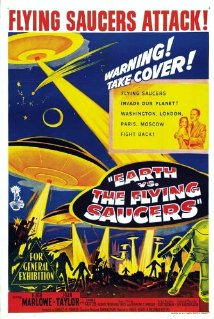At the time, spectacle of the scope of flying saucers tearing through the Capitol must have been stupendous to watch. Independence Day owes everything to it. It is still impressive to watch, we have Ray Harryhausen to thank for that. He did quite a bit of work, less on saucer design, which is simple and carried over from the lurid covers of pulp magazines of the day, and more on the seamless engineering together of different worlds.
You have the fictional world of the story of an alien invasion, of Pentagon meetings and running around to prevent disaster. It is not the best acted you have seen, but works from a scenario that seems more credible than most of this ilk. It does the job of lowering you into a situation that for a sizable portion of 1950’s North Americans, was a less distant threat than you may think.
You have stock footage of real disaster; real ships and bombers blowing up, exploding V2 rockets and buildings, solar flares, floods. This registers in a powerful way. In fact, I am convinced that the majority of viewers when they celebrate Harryhausen’s SFX work in the film, subliminally include these pieces into a single impression of havoc.
And you have Harryhausen’s vision of alien gizmo and destruction. The genius is not in any individual effect, though several are quite well done they stick – and others a bit corny. His envisioned interior of a saucer deserves mention, with a rose-petal shaped ‘translator’ and cinematic screen. As mentioned though, what really grabs you is the seamlessly choreographed blend of real and staged destruction. And while Emmerich’s film is more visually pompous, this impresses me more because they couldn’t construct everything on a computer in those days.
It works to this day, as many will testify. It does, because overall it achieves a remarkable illusion, and cinematic vertigo is to this day the primary draw to movies, that dazed feeling of weightless escape into a second world.
I have noted elsewhere that deep down we are psychotic beings – this is foremostly revealed in acts of love and war, as well as powerful cinema. Logic does not spin our world, though we have to pretend to that effect. In fact, logic is a (relatively) recent adoption – for millenia, we relied on extra-logical capacities for survival, and their denial in modern life is a main cause of anxiety.
Anyway, I am collecting examples of this in film and this is a prime one – psychotic in both the making and viewing levels.
You see, among the alien gizmos that intrigue here (fluid ‘alien vision’!), are remote-controlled balls of fire, initially mistaken for St. Elmo’s fire.
Now, during WWII, among the most baffling news topics to reach back home from the front, was reports of strange balls of fire encountered by airmen on night missions. The ghostly apparitions would mysteriously appear and chase after the planes in a way that seemed they were under intelligent control.
Initially thought to be superior German jet technology, hundreds of reported sightings of these UFOs poured in from ally aircrews all over Western Europe, usually seen by two or more people on the same bomber. British crews reported them, Canadian, and as it turned out after the war, the Germans did as well. US crews flying over the Pacific knew them as ‘bakas’ or ‘robombs’, and thought them Japanese.
So this was the first massively reported (and at the time, credible-seeming) sighting of UFOs, the whole craze with flying saucers wasn’t going to blow open until a few years after the war. Naturally, these floating fires were lumped in the same category when it did. So when this was made a decade later, filmmakers were tapping into fearful public knowledge of these things, not easy to appreciate now that they are things of parody. In a 1950 Gallup poll, more Americans professed knowledge of what a ‘flying saucer’ is than they did of a ‘Cold War’.
A similar notion of floating lights encountered by travelers at night goes back to more ancient times however, you will know it as will-o’-the-wisp or Jack-o-lantern. Folk story has its own explanation of these, as does science – that is its own debate. Whatever the thing really was, what travelers were responding to was a projection of fears, not simply a natural occurrence, but the devil’s light (or spirits’) out for mischief.
And the most credible and likely explanation of the WWII version of these night lights, is aviation vertigo, pure optical illusion – not very well researched at the time.
How is this psychotic? Natural phenomena occur around us, including in our field of perception, illusory mind images. We invent stories around them. We invent intelligent illusion. And with cinema, the magic of industrial light, we invent optical illusions to convincingly perpetuate optical illusions, and as viewers we pay to inhabit them for a while. It is a direct line from the medieval traveler’s Jack-o-lantern to what those pilots experienced in flights, to what we do in our flights of seeking illusory sensations in the dark of the theater.

